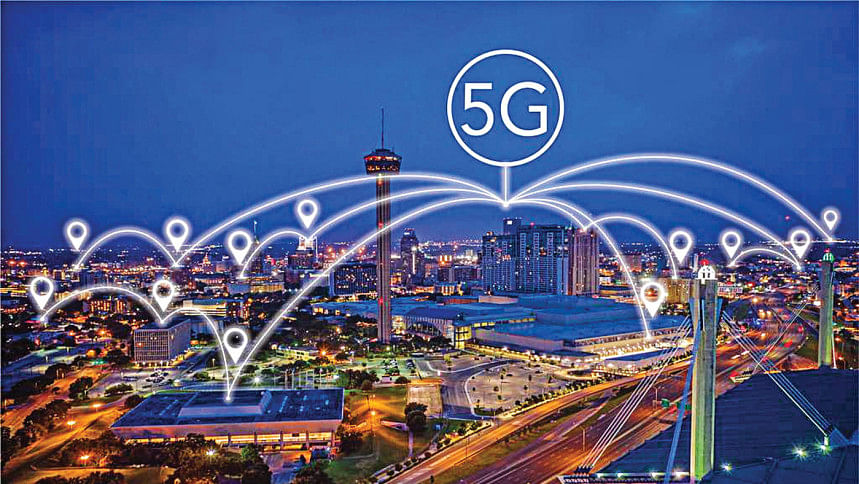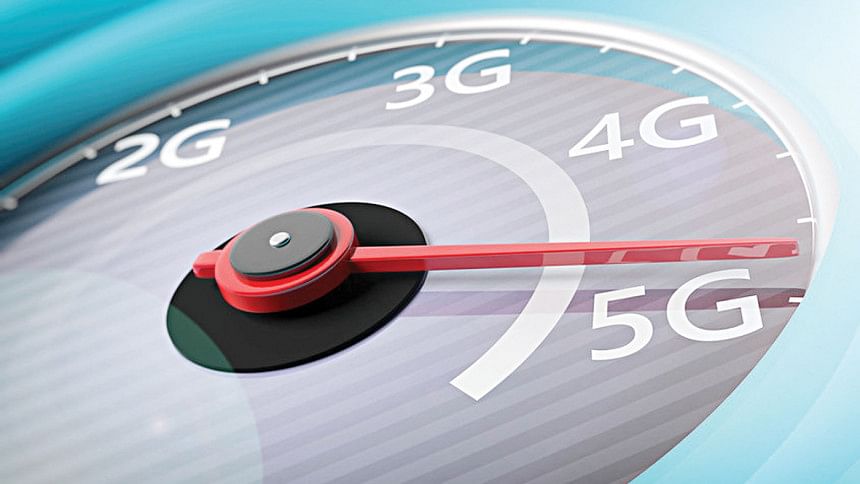5G for Bangladesh: Navigating between high hopes and hard realities

As Bangladesh enthusiastically gears up for the advent of 5G technology, a centrepiece of its Vision Smart Bangladesh 2041, the mood is a mix of optimism and caution. The transition to 5G is not just an upgrade in telecommunications; it represents a significant technological leap. This leap, however, is fraught with complexities that demand a thorough, objective examination.
The common perception of 5G, often oversimplified as a fast lane for enhanced internet services like streaming, only skims the surface of its implications. 5G technology, in essence, promises a transformative leap in connectivity, enabling a broad spectrum of applications, from smart cities to remote healthcare. However, the leap from the current 4G to the more sophisticated 5G is not merely an upgrade; it's a paradigm shift. The biggest question here remains: is Bangladesh truly ready for this seismic shift?
The common perception of 5G, often oversimplified as a fast lane for enhanced internet services like streaming, only skims the surface of its implications. 5G technology, in essence, promises a transformative leap in connectivity, enabling a broad spectrum of applications from smart cities to remote healthcare.
Recent data depict a Bangladesh rapidly embracing digital connectivity. With over 190 million mobile users and 127 million internet subscribers (according to BTRC), the country has made strides in digital adoption. However, this progress has not been without challenges. The existing 4G network, while widespread, grapples with issues like variable network quality, limited bandwidth in rural areas, and occasional service disruptions. These issues are not trivial; they underscore the foundational gaps that could hinder the effective rollout of 5G.
In rural regions, where internet penetration has increased, the quality and consistency of connectivity remain concerns. This digital divide is not just a matter of network coverage; it extends to aspects like access to devices, digital literacy, and affordability. These factors are critical when considering the readiness for 5G, a technology that demands more sophisticated infrastructure and user engagement.
On the industrial front, 5G holds immense promise. It can transform industries by enabling real-time data processing, facilitating IoT (Internet of Things) applications, and enhancing operational efficiencies.

For instance, in agriculture, a sector vital to Bangladesh's economy, 5G can enable precision farming techniques, leading to better crop yields and resource management. In manufacturing, 5G can power smart factories, leading to increased automation and productivity.
However, the leap to these advanced applications is not straightforward. The current industrial infrastructure in Bangladesh is not at all in any capacity equipped to integrate 5G. The readiness extends beyond mere technological upgrade; it involves training the workforce, updating industrial practices, and ensuring robust cybersecurity measures. These are significant undertakings that call for substantial investment and strategic planning.
The potential of 5G to exacerbate the existing digital divide is a pressing concern. The benefits of 5G could be disproportionately enjoyed by urban and affluent segments, leaving behind rural and poor populations. Bridging this divide requires more than just expanding network coverage. It involves making technology accessible and affordable, ensuring that the fruits of digital advancements are equitably shared.
Efforts to reduce this divide must include policies that prioritise rural connectivity, subsidies for affordable access, and programs that enhance digital literacy. Without these measures, 5G could become another layer in the stratification of digital access, contrary to the inclusive growth envisioned in Bangladesh's digital transformation agenda.
The security implications of 5G are another critical aspect. Given the recent history of cyber-attacks in Bangladesh, the move to a more complex and expansive 5G network raises legitimate concerns. The architecture of 5G networks, while offering numerous advantages, also presents new challenges in terms of security. These networks are more distributed and rely heavily on software, making them potentially more vulnerable to attacks.
Strengthening cybersecurity infrastructure becomes imperative in this context. This involves not just technological upgrades but also comprehensive policies, skilled human resources, and public-private partnerships to foster a robust cybersecurity ecosystem. The cost of neglecting these aspects could be high, considering the integral role of telecommunications in national security and economic stability.
The readiness for 5G also involves a cultural and educational shift. A significant portion of the Bangladeshi population, particularly in rural areas, is still acclimatising to the basics of digital technology. Introducing 5G in this scenario is not just a technological challenge; it's about facilitating a cultural transition.
This transition demands concerted efforts in digital education and awareness. The general populace needs to be educated about the benefits and potential risks of 5G. Simplifying technology for end-users, offering training programs, and promoting digital literacy are essential steps in making 5G a technology for all, not just for the tech-savvy or the urban elite.

The journey of Bangladesh towards 5G is emblematic of a nation aspiring for technological advancement while grappling with ground realities. The enthusiasm for 5G is palpable, but it is accompanied by a spectrum of challenges that need careful navigation. Addressing infrastructural gaps, bridging the digital divide, enhancing cybersecurity, and fostering digital literacy are not just preparatory steps; they are indispensable elements of a successful and inclusive 5G rollout.
As Bangladesh stands at this technological juncture, a balanced, inclusive, and security-conscious approach will be key. The success of 5G in Bangladesh will ultimately be measured not just by the speed of the internet it delivers but by how well it integrates into the fabric of society, enhancing lives across the nation. The path to 5G is as much about building robust networks as it is about fostering a digitally empowered and secure society.
Shahriar Rahman is a veteran digitech policy analyst specialising in the APAC region and a doctoral candidate researching 5G at RMIT University, Australia

 For all latest news, follow The Daily Star's Google News channel.
For all latest news, follow The Daily Star's Google News channel. 



Comments